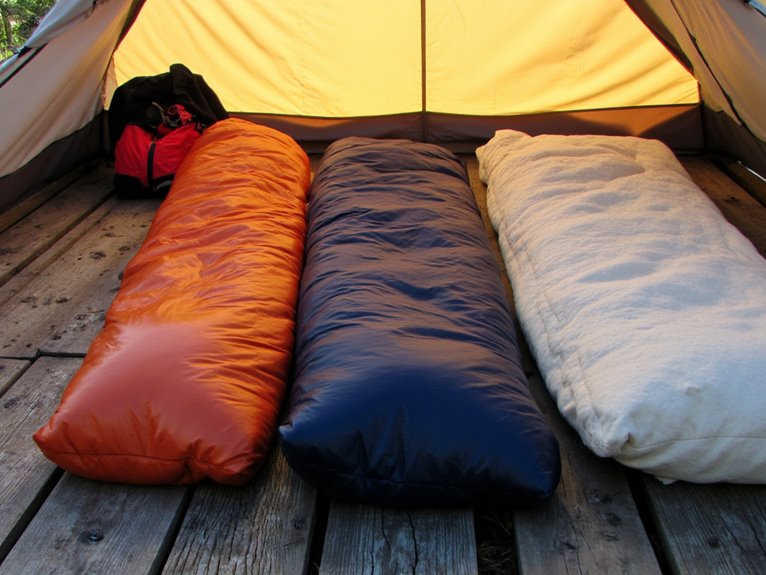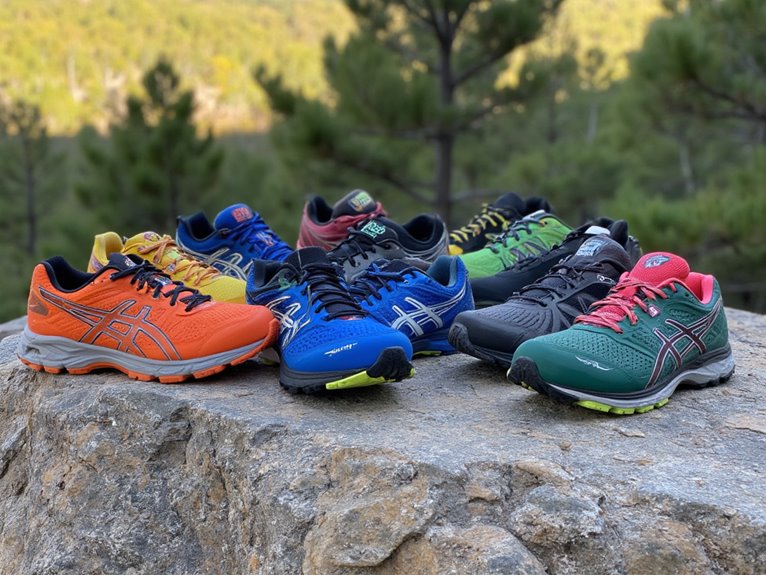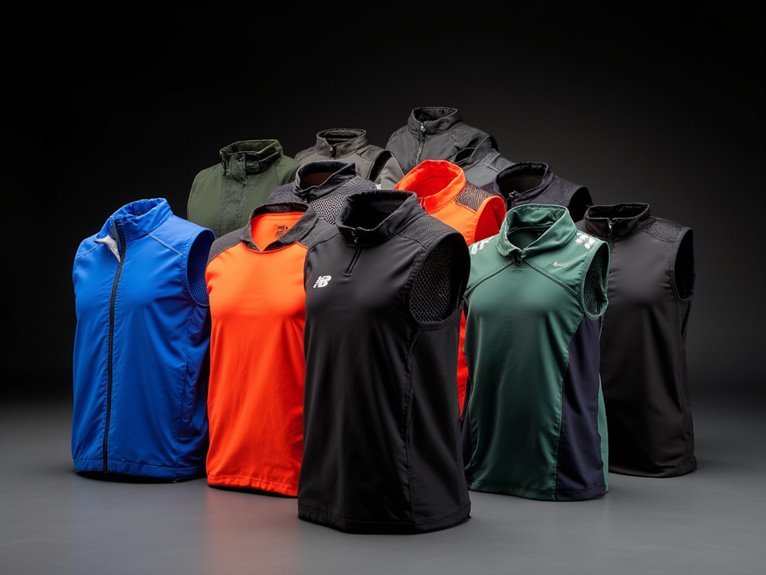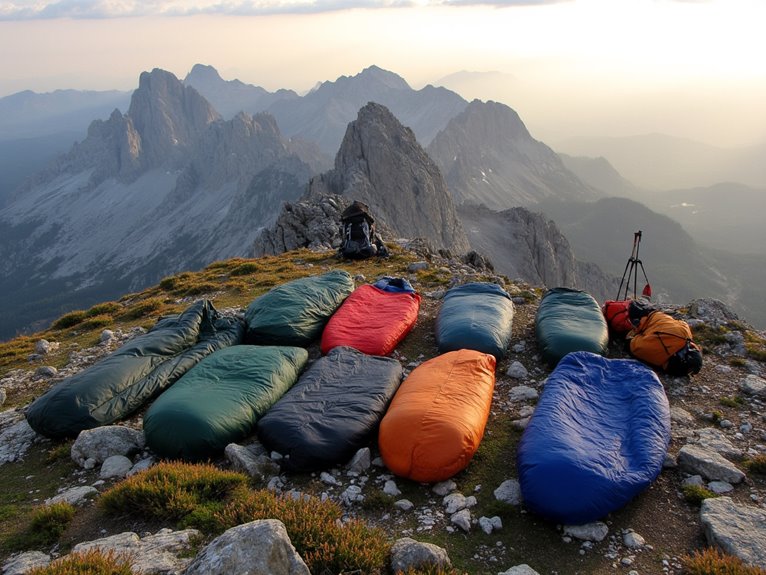Sleeping Bag Liners: Silk vs. Synthetic vs. Merino Wool Compared
You’ll find silk liners offer the best packability at 3.6-5 oz while adding 9.5°F warmth, making them ideal for ultralight summer trips. Synthetic options like Thermolite provide excellent durability and moisture-wicking for $20-80, adding 10-25°F warmth but weighing 12.6-13.8 oz. Merino wool delivers superior temperature regulation and 12.6°F warmth increase, lasting 8-15+ seasons despite higher costs of $100-200 and 14.2-17.5 oz weight. Each material transforms your three-season bag into winter-capable gear through different performance advantages.
We are supported by our audience. When you purchase through links on our site, we may earn an affiliate commission, at no extra cost for you. Learn more. Last update on 5th December 2025 / Images from Amazon Product Advertising API.
Notable Insights
- Silk liners are ultralight (3.6-5 oz) and most packable, synthetic liners offer superior durability and moisture-wicking, merino wool provides best insulation.
- Warmth performance varies: silk adds 9.5°F, synthetic adds 10-25°F, merino wool adds 12.6°F to sleeping bag temperature ratings.
- Silk excels in summer/tropical conditions, synthetic works best for spring/fall, merino wool performs optimally in winter and high-altitude environments.
- Cost ranges from $20-80 for synthetic, $60-120 for silk, and $100-200 for merino wool with varying lifespans of 1-3, 5-10, and 8-15+ seasons respectively.
- Merino wool offers best long-term value despite higher upfront cost, while synthetic provides budget-friendly entry point for occasional users.
Material Properties and Performance Overview
When you’re choosing a sleeping bag liner, the material fundamentally determines every aspect of its performance.
Silk offers exceptional packability at roughly 5 ounces with moderate breathability and luxurious comfort. However, it’s delicate and requires careful handling.
Synthetic options like Thermolite and Coolmax excel in durability while maintaining lightweight characteristics and superior moisture-wicking capabilities. These materials dry quickly and withstand frequent washing cycles.
Merino wool provides natural antimicrobial properties with excellent temperature regulation, though it weighs slightly more than alternatives.
Cotton delivers familiar comfort but adds bulk and retains moisture problematically.
Fleece liners offer the greatest thermal performance, adding 10-15°F of warmth but come with increased weight and bulk compared to other materials.
Fabric comparisons reveal distinct trade-offs between weight, durability, and performance characteristics. User preferences typically center on balancing packability against comfort needs, with synthetic materials offering the most versatile performance across varying conditions and maintenance requirements.
Warmth and Temperature Rating Enhancements
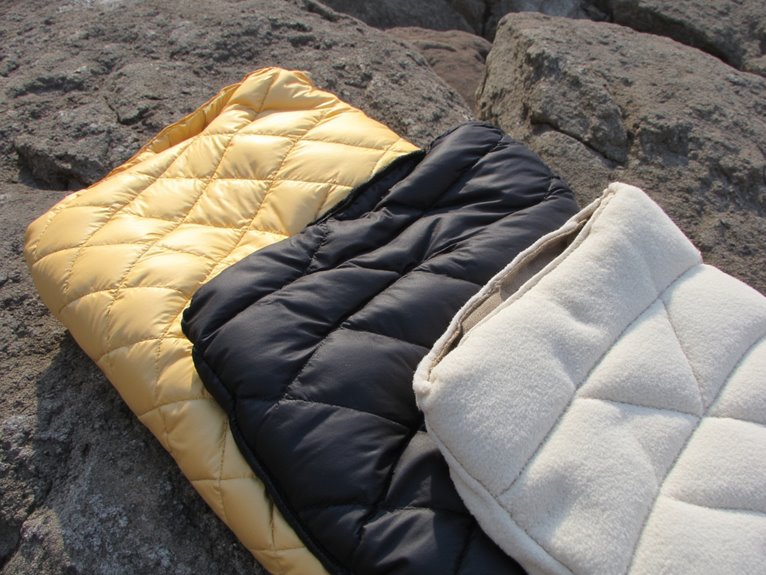
When you’re evaluating sleeping bag liners, material insulation performance directly determines how much warmth you’ll gain from your investment.
A medium-weight microfleece liner adds approximately 14.3°F to your sleeping bag’s temperature rating, while merino wool provides about 12.6°F of additional warmth, and organic cotton delivers only 5.3°F.
These temperature rating boosts can transform a three-season sleeping bag into winter-capable gear without requiring you to purchase an entirely new sleep system.
Unlike your sleeping bag’s primary insulation, liners retain their thermal efficiency even when exposed to moisture, making them particularly valuable for humid conditions where down insulation would lose significant performance.
Material Insulation Performance
How effectively does a sleeping bag liner boost your sleep system’s thermal performance? The answer depends on critical insulation factors that vary greatly between materials. Performance metrics reveal substantial differences across silk, synthetic, and merino wool options.
Here’s how each material delivers thermal enhancement:
- Synthetic liners trap air within hollow-core fibers, adding 10-25°F warmth while incorporating infrared-absorbing pigments for maximum heat retention.
- Merino wool liners create insulating air pockets through crimped fiber structure, maintaining consistent thermal performance even when damp.
- Silk liners provide moderate insulation through natural strength-to-weight ratios, though they’re less thermally efficient than synthetic alternatives.
- Moisture management directly impacts insulation effectiveness, with quick-drying synthetics and wool’s absorption properties preventing evaporative cooling that compromises thermal performance.
Temperature Rating Boosts
Beyond insulation mechanics lies the practical question of quantifiable warmth gains. Your liner’s thermal boost comparison reveals significant material differences.
Fleece liners provide the highest performance, adding up to 8°C (14°F) to your bag’s temperature rating.
Synthetic options like Sea to Summit’s Reactor series offer moderate gains: standard models add 4°C (7°F), while Extreme versions boost warmth by 6°C (10°F).
Silk liners deliver minimal thermal enhancement despite their comfort benefits.
Liner effectiveness depends on your base sleeping bag’s insulation level. Higher-rated bags experience smaller relative improvements from liners.
Thicker synthetic materials consistently outperform silk in measurable warmth gains.
Your sleeping system’s overall performance combines liner warmth with pad R-values and bag insulation, creating an additive temperature rating enhancement rather than replacement insulation.
Breathability and Comfort Features
Your sleeping bag liner’s ability to regulate temperature and manage moisture directly impacts your sleep quality during outdoor adventures.
Different materials handle these functions through distinct mechanisms—merino wool naturally wicks sweat away from your skin while maintaining breathability, synthetic fabrics like polyester dry quickly but may feel less comfortable against your body, and cotton absorbs moisture effectively but takes considerably longer to dry.
Understanding how each material’s temperature regulation properties and moisture management systems work together helps you select the right liner for your specific sleeping conditions and personal comfort preferences.
Temperature Regulation Properties
Temperature regulation stands as the most critical performance factor when selecting a sleeping bag liner, directly impacting your comfort throughout the night.
Each material offers distinct thermal properties that affect your sleep quality and climate adaptation capabilities.
Here’s how each liner type manages temperature regulation:
- Silk liners provide excellent breathability with minimal warmth addition, making them ideal for hot climates where moisture vapor escape is essential.
- Synthetic liners offer moderate breathability while adding 5°F to 15°F of warmth, creating versatility for temperate conditions.
- Merino wool liners deliver superior insulation with maintained breathability, perfect for colder environments requiring both warmth and moisture management.
- Seasonal optimization varies greatly: silk for summer, synthetic for spring/fall, and merino wool for winter applications.
Moisture Management Systems
While temperature regulation determines your baseline comfort, moisture management systems control whether you’ll wake up feeling refreshed or clammy throughout the night.
Synthetic materials like Coolmax excel at moisture absorption and rapid transfer away from your skin. These technical fabrics feature engineered fiber structures that pull sweat to the surface for quick evaporation.
Wicking efficiency varies greatly between materials—synthetic liners process moisture 3-4 times faster than silk.
Merino wool offers balanced moisture management through natural fiber properties. Its breathable structure absorbs up to 30% of its weight in moisture while maintaining dry surface contact.
Silk provides comfort but lacks aggressive moisture transfer capabilities.
Advanced liners incorporate moisture spreading technology, distributing sweat across larger surface areas for enhanced evaporation rates.
Durability and Care Requirements
When choosing a sleeping bag liner, durability and maintenance requirements vary significantly across materials, directly impacting your long-term investment and trail experience.
Key durability factors determine your liner’s lifespan:
- Synthetic materials offer superior abrasion resistance and fast-drying properties, requiring minimal maintenance.
- Merino wool provides excellent wear resistance across environmental conditions but needs careful hand washing.
- Polyester delivers maximum durability with quick-drying capabilities and compact storage options.
- Silk offers luxury comfort but requires gentle handling and potential dry cleaning.
Understanding these care tips guarantees peak performance.
Synthetic and polyester liners withstand folding and harsh conditions.
Merino wool performs well environmentally but demands proper storage in cool, dry locations.
Silk degrades faster in humidity and needs careful handling to prevent damage during storage and cleaning.
Similar to sleeping gear maintenance, all liner materials benefit from hand washing with mild soap and warm water rather than machine washing, which can damage technical fabrics and reduce their performance over time.
Environmental Condition Suitability
Each sleeping bag liner material responds differently to environmental challenges, making material selection critical for ideal performance across varying conditions.
Silk excels in tropical conditions due to its exceptional breathability, keeping you cool while adding up to 9.5°F of warmth when temperatures drop. Its natural fibers handle humidity effectively without moisture buildup.
Synthetic polyester offers superior moisture-wicking properties and quick-drying capabilities, making it reliable in humid environments. However, it’s less breathable than natural materials.
Merino wool provides the best altitude adaptability, regulating body temperature across extreme ranges from cold high-altitude nights to warm valley days. Its natural moisture management prevents clamminess in humid conditions while maintaining warmth retention in cold weather, making it the most versatile choice for variable climates.
Weight, Packability, and Portability

Beyond environmental performance, the physical characteristics of weight, packability, and portability greatly impact your gear selection for different types of outdoor adventures.
When usage scenarios involve strict weight limits, these factors become critical decision points.
- Silk liners weigh 3.6-5 oz and compress to a medium handful size, making them ideal for ultralight backpacking.
- Synthetic liners range 12.6-13.8 oz and pack down to softball size, offering balanced performance for most trips.
- Merino wool liners weigh 14.2-17.5 oz and compress to large grapefruit size, limiting space for other gear.
- Cotton and fleece liners exceed 15 oz with poor compression ratios, suitable only for car camping scenarios.
Silk provides the best weight-to-warmth-to-packability ratio for space-conscious users.
Like sleeping bags that vary from 2 to 8.5 pounds, liners require compression sacks for optimal transport and storage efficiency during backpacking trips.
Cost Analysis and Value Comparison
While silk liners command premium prices between $60-$120, synthetic options deliver the broadest affordability range at $20-$80, making initial cost a major decision factor for most outdoor enthusiasts.
| Material | Initial Cost | Lifespan | Cost Per Season |
|---|---|---|---|
| Synthetic | $20-$80 | 1-3 seasons | $20-$40 |
| Silk | $60-$120 | 5-10+ seasons | $8-$20 |
| Merino Wool | $100-$200 | 8-15+ seasons | $7-$20 |
Merino wool represents the luxury tier at $100-$200, yet delivers exceptional cost efficiency through superior price longevity. You’ll replace synthetic liners every 1-3 seasons, while silk and merino maintain performance for years with proper care. Budget-conscious backpackers benefit from synthetic’s low entry cost, but frequent users should calculate total ownership expenses. Silk’s moderate upfront investment balances durability with performance, often providing the best long-term value proposition. Quality liners justify their cost by extending your sleeping bag’s lifespan by 3-5 years through effective hygiene maintenance.

